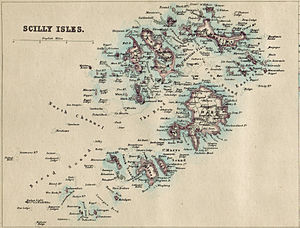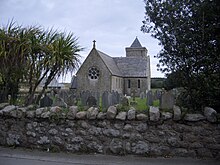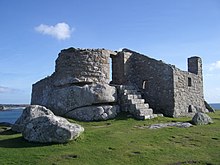Tresco
| Tresco | ||
|---|---|---|
| View of Tresco ( Bryher Island in the background ) | ||
| Waters | Celtic sea | |
| Archipelago | Isles of Scilly | |
| Geographical location | 49 ° 57 '9 " N , 6 ° 20' 7" W | |
|
|
||
| surface | 2.97 km² | |
| Highest elevation |
Beacon Hill 42 m ASL |
|
| Residents | 180 61 inhabitants / km² |
|
| Isles of Scilly on historical map from 1874 | ||
Tresco ( Cornish : Ynys Skaw ) is the second largest island in the Isles of Scilly in the United Kingdom . The island offers a variety of landscape formations; from rugged granite rocks to white sand beaches. It belongs to the Duchy of Cornwall and was leased by the Dorrien-Smith property management company, which grants part-time housing rights there.
The three settlements New Grimsby, Borough and Old Grimsby are located in the middle of the island and have a total of 180 inhabitants. In contrast to the rest of the Isles of Scilly, which are mostly undeveloped for tourism, Tresco is a sought-after resort whose economy is determined by tourism. The Tresco Heliport also gave Tresco a direct airline connection to the mainland. On October 31, 2012, all flights were suspended and the heliport closed.
geography
Geographical location
Tresco is located in the southwest of England at the western entrance to the English Channel and is part of the Isles of Scilly . With 2.97 km² it is the second largest island in the group. In the south of Tresco there are two small brackish lakes, the Great Pool and the Abbey Pool . The highest point on the island is Beacon Hill with a height of 42 meters. The neighboring island of Bryher, which is also inhabited, is partially only 300 meters away from Tresco. Around the island there are also many small craggy rocks and other islands rise from the sea. The Pentle Bay in southeastern Tresco offers visitors an over one kilometer long white sand beach.
climate
Tresco has a very temperate climate and the thermometer rarely drops below 4 ° C even in winter. Between May and September, the maximum temperatures are usually between 15 ° C and 20 ° C. In the average of 238 rainy days per year, around 700 mm of rain falls.
Population development
The figures given only refer to the permanent residents on the island. Another large number of seasonal workers also live on Tresco during the summer months.
|
|
|
Culture and sights
Archaeological sites
Many traces and graves have been found on Tresco, suggesting that the island was inhabited as early as the Neolithic.
- At the Appletree Bay there are traces of a prehistoric agriculture. The remains of two houses and a field from the same period were found just 100 m east of it. Parts of these two sites can only be seen at low tide.
- Remains of other houses and fields from the Neolithic Age have been discovered on Tregarthen Hill .
- There are 78 stone graves at Castle Down (the northernmost hill on the island) and in the surrounding areas . Some of them are probably from a later time.
- There is a burial mound near Borough, a small farm on Tresco.
St. Nicholas Church
Tresco had a small church since 1798, which was enlarged in 1824 and 1835. On September 12, 1877, Edith Dorrien-Smith laid the foundation stone for a new building on the same site. From June 17, 1879, the first services were held in the new Anglican Church of St. Nicholas. It was consecrated three years later on July 16, 1882. The organ of the church was completed by the organ builder Eustace Ingram in 1886.
Military buildings
- The artillery fortress King Charles's Castle , built between 1550 and 1554 under Edward VI. was built by England , is located on the hill Castle Down in the north of the island. In the back of the building there were rooms where the garrison could spend their free time. During the English Civil War , a protective wall was built around the fortress to stop intruders by land. Parts of the building were later used to build the new Cromwell's Castle fortress. The current ruin is managed by the English Heritage Agency.
- Cromwell's Castle turret was built by Oliver Cromwell between 1651 and 1652 to replace King Charles's Castle. The weapons were on the roof above the garrison and warehouse quarters. Originally, an outside staircase on the south side went to the first floor. The building in its current form has only existed since the 1740s. The turret was supposed to secure the anchorages between Tresco and Bryher.
- The Old Blockhouse turret was built to protect the Old Grimsby docks, which were vigorously defended during the English Civil War. The tower was probably built between 1548 and 1552.
- The Oliver's Battery turret is located in the south of the island. Admiral Robert Blake had it built shortly after the Roundheads conquered Tresco in the English Civil War.
More Attractions
- A memorial to the former owner of the Isles of Scilly Augustus Smith sits on Abbey Hill.
- At the height of Castle Down are the remains of an old tin mine, which was abandoned around 1640 due to lack of economic viability.
Regular events
Since 2010 a triathlon has been held on Tresco every year. It is the replacement for the marathon founded in 2001, which consisted of 7.5 island tours and at the same time was a benefit event for the benefit of cystic fibrosis sufferers. The event always took place on the same day as the London Marathon . The triathlon starts at Ruin Beach Cafe with a 0.36 mile swim, 12 mile bike ride, and 3 mile run.
The island also hosts traditional pilot gig boat races and various types of swimming competitions.
Nature and parks
Tresco Abbey Gardens
It is the only public park on Tresco and about 0.7 hectares in size. It is located on the site of a former Benedictine abbey. The gardens were only laid out in 1834 by the aristocratic anthroposophist Augustus Smith, who was the owner of the Isles of Scilly for a long time and who had devoted himself to fighting hunger with the creation of a kitchen garden . Thanks to the mild climate and lots of sun in summer, subtropical plants from all over the world thrive in the park. The many hedges and the walls of the garden also protect the plants from the wind. The monastery, which was built in 1144, is hardly mentioned in documents after the 15th century. It was probably abandoned before the Reformation, as it could not counter the constant attacks by pirates and thieves. The medieval pointed arches of the monastery were integrated into the park. Smith got the seeds and plants from Kew Gardens in London .
There is also a collection of over 30 figureheads in the park . They come from the many shipwrecks that were shipwrecked on the Isles of Scilly during the 19th century.
Nature reserves
Two areas on Tresco have been designated as Sites of Special Scientific Interest :
The Great Pool is one of Tresco's two brackish water lakes, which offers a wide variety of fauna and flora. It is about one kilometer long and divides the island into a southern and a northern part. In the shallow water at the edge of the lake, a lot of crested spawn grows next to the common reed . The broad-leaved cattail is also very common there. Common rush and king fern thrive in the marshy salty soils along the lake shore . On the north side of the Great Pool there are also many gray willows as well as common pennywort and swamp irises . The smelly iris , creeping buttercup , lesser celandine and blackberry bushes can be found on the somewhat drier bank areas . The habitat for the figwort species Scrophularia scorodonia, which is very rare in England, is particularly valuable .
Many different species of birds breed in the reeds and in the surrounding area of the lake, including mute swans , mallards , gypsies , water rails , reed warblers and pond warblers . Furthermore, many birds use the Great Pool and Tresco as wintering areas, such as teal , wigeon , shoveler , pochard and tufted duck . In autumn you can see many birds from Eurasia and sometimes wanderers from North America.
Castle Down is a wind-shaped landscape in the north of the island. Besides heather and the horror Heide also here Western Gorse ( Ulex gallii ) found. Between them grow bloodroot , trefoil , heath bedstraw , the Fettenhennen -Art Sedum anglicum and bracken .
The endemic lichen species Heterodermia propagulifera , which can also be found on the rest of the island, together with Heterodermia leucomelos and Heterodermia obscurata, is unique . In addition to the Isles of Scilly, the genus Heterodermia also grows in the Channel Islands and along the Breton coast. Among the 45 species of lichen in this area are many lung lichens that grow on common heather, as well as some species of the lichen genus Cladonia . Castle Down is also an important breeding area for common terns .
caves
Piper's Hole is a nearly 100 meter long cave on the north coast of Tresco with a relatively narrow entrance. In some places the cave, which has a large lake, is sometimes over ten meters high. Good shoes and torches are required for the inspection. There is also a population of the canopy spider species Halorates reprobus in the cave .
The place was a popular hideout for smugglers in earlier times. Ethel Smyth , who explored several such smuggler caves on a visit to the Isles of Scilly, is said to have particularly impressed Piper's Hole and to have influenced the design of her opera The Wreckers . Locals claim that there is an underground connection between the cave on Tresco and the cave of the same name on St Mary’s .
The Gun Hole is only 300 meters from Piper's Hole on the northwest coast. At around 20 meters in length, it is a relatively small cave. But it has a fresh water source; the only one in all of Tresco.
traffic
Cars are not allowed on the island. However, tractors are available to transport the arriving tourists and golf carts are available for disabled visitors . In addition, travelers have the option of renting bicycles.
The island, like St Mary's, had a flight connection to the mainland through the Tresco Heliport . The resident airline British International Helicopters flew up to six times a day to the helipad in Penzance in Cornwall . The number of take-offs and landings is usually reduced in the winter months. On October 31, 2012, all flights were suspended and the heliport closed.
In addition, a few passenger ships and excursion boats go from the island's ports to the other inhabited islands. The travel times depend on the tides.
Tresco in art and literature
The impressive landscape and the history of Tresco is captured in several artistic works:
- In the children's novel as the whales came from Michael Morpurgo , the Isles of Scilly Tresco and are mentioned several times.
- The novel Hell Bay of Sam Llewellyn tells fictitious events on Tresco.
- The novel Storm Islands of Ann Quinton plays on Tresco and the Isles of Scilly.
- In the 1989 literary film adaptation of Prince Caspian & The Journey on Dawn , some scenes were filmed on Tresco (as the location for the Lonely Islands ).
- Many of the pictures showing views of Tresco are by the English painter John Miller (1931–2002).
literature
- Crispin Gill: The Isles of Scilly. David & Charles, Newton Abbot 1975, ISBN 0-7153-6957-1 .
- Jeanette Ratcliffe: Scilly's Archeological Heritage. Twelveheads Press, Truro 1992, ISBN 0-906294-28-2 .
- Ronald King: Tresco: England's Island of Flowers. Constable, London 1985, ISBN 0-09-466170-7 .
- Arthur Robert Dorrien-Smith: The Tresco Abbey Gardens. Jarrold and Sons, Norwich 1970, ISBN 0-85306-225-0 .
Web links
- Tresco Estate (English)
- Tresco heliport. In: Helicopter Database (English; via search function)
- Magical gardens. Tresco Abbey. In: arte.tv. Arte - Description of the film for the documentation by Timo Ebermann (director), France 2017, ARTE France , 27 min.
- Documentary Scilliy Islands with Tresco. In: wgsebald.de (private website)
Individual evidence
- ↑ Magical Gardens. Tresco Abbey. ( Memento from March 11, 2018 in the Internet Archive ) In: arte.tv. Arte , accessed on March 11, 2018 - Description of the film for the documentation by Timo Ebermann (director), France 2017, ARTE France , 27 min.







